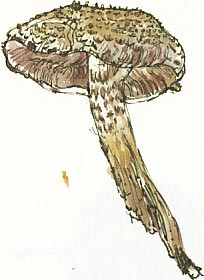
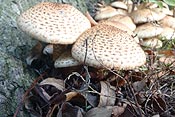 Shaggy Scalycap
Shaggy Scalycap
 Shaggy Scalycap
Shaggy ScalycapWild West Yorkshire, Sunday 24 October 2010, page 1 of 2
previous | this month | next
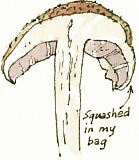
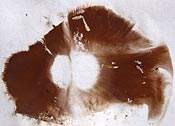 FROM A DISTANCE I guessed that the fungi growing around the base of a tall old ash tree in Thornhill Park was honey fungus but, when I took a closer look, I saw that the cap and the most of the stem was covered in brown scales. Honey fungus can be variable and occasionally you'll find it sparsely covered with scales, but this was more distinctive.
FROM A DISTANCE I guessed that the fungi growing around the base of a tall old ash tree in Thornhill Park was honey fungus but, when I took a closer look, I saw that the cap and the most of the stem was covered in brown scales. Honey fungus can be variable and occasionally you'll find it sparsely covered with scales, but this was more distinctive.
Shaggy Scalycap, Pholiota squarrosa, also grows around the base of beech trees. It's inedible but the pale yellow flesh is said to smell of radishes. It has brown spores, as you can see in the spore print I took of the cap (left).

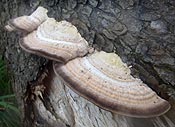 The Blushing Bracket
The Blushing BracketIn February 2000 in this diary I drew an old horsechestnut tree in Thornhill Park which had so many cavities in the trunk that I imagined I could see a face in it. Not surprisingly, ten years later it has been felled but the trunk has been left in situ and these bracket fungi are now growing from it.
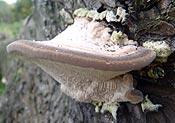
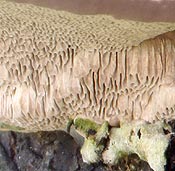 I think this must be the Blushing Bracket, Daedaleopsis confragosa (a.k.a. Trametes rubescens), as, although there are a number of similar-looking species of bracket fungus, this one is noted for the variability of the pores on the underside of the bracket (right); they can be small and round, elongated or maze-like. The shape of the spores themselves is also very variable.
I think this must be the Blushing Bracket, Daedaleopsis confragosa (a.k.a. Trametes rubescens), as, although there are a number of similar-looking species of bracket fungus, this one is noted for the variability of the pores on the underside of the bracket (right); they can be small and round, elongated or maze-like. The shape of the spores themselves is also very variable.
It gets its name because the flesh blushes red when bruised. Another species is known as the Blueing Bracket as it turns grey-blue when handled.
Richard Bell, illustrator
previous | this month | Wild West Yorkshire home page | next